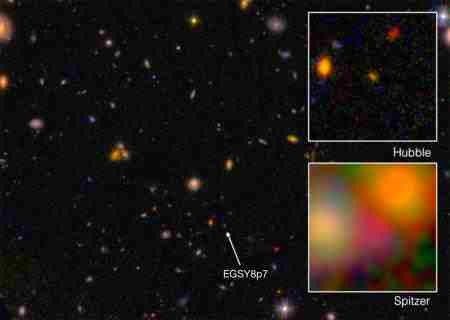In the quest of finding the oldest cosmic objects in the universe, a team of astronomers has now detected the most distant galaxy to date, making it the oldest galaxy ever discovered, originating from the dawn of time.
According to the authors of the study, Adi Zitrin who is a postdoctoral scholar in astronomy from NASA and Richard Ellis from the California Institute of Technology (Caltech), they believe that a certain galaxy called the EGS8p7 is estimated to be over 13.2 billion years old where the universe itself is estimated to be 13.8 billion years old.
Earlier this year, galaxy EGS8p7 was first detected and was considered as a possible candidate after a thorough investigation based on data consolidated from NASA's Hubble Space Telescope and the Spitzer Space Telescope.
In order to conduct an in depth analysis of the galaxy, researchers used the telescope's Multi-Object Spectrometer For InfraRed Exploration or MOSFIRE at the W.M. Keck Observatory in Hawaii to further determine the redshift of the galaxy. This redshift found in galaxies is analyzed by astronomers to pinpoint the color shift of the light that emanates from the galaxy that gives off a Doppler effect.
Apart from this, redshift is also often utilized to measure how distant a galaxy is, however, observing extremely distant objects during the early years of the universe is rather difficult. After the Big Bang event, the universe was just made up of a scattering of charged particles.
Since photons are being dispersed by free electrons right after the Big Bang, the infant universe cannot transmit or transfer light. It will take another 380,000 years after the Big Bang for the universe to cool down in the most ideal conditions for free electrons and protons to combine, finally allowing light to emanate throughout the universe.
Galaxy EGS8p7 is considered to be truly ancient however, scientists became somewhat confused when they detected some of the light signatures from the galaxy's emissions that were too bright for a galaxy of that age.
This is apparently caused by neutral hydrogen that absorbed much of the light from many stars throughout eons, which was not found for one billion years until light was able to travel the universe. Scientists also believe that the reason why galaxy EGS8p7 exudes so much brightness is that, it possesses an extremely hot core of stars.
This new study is published in the Astrophysical Journal Letters.



























